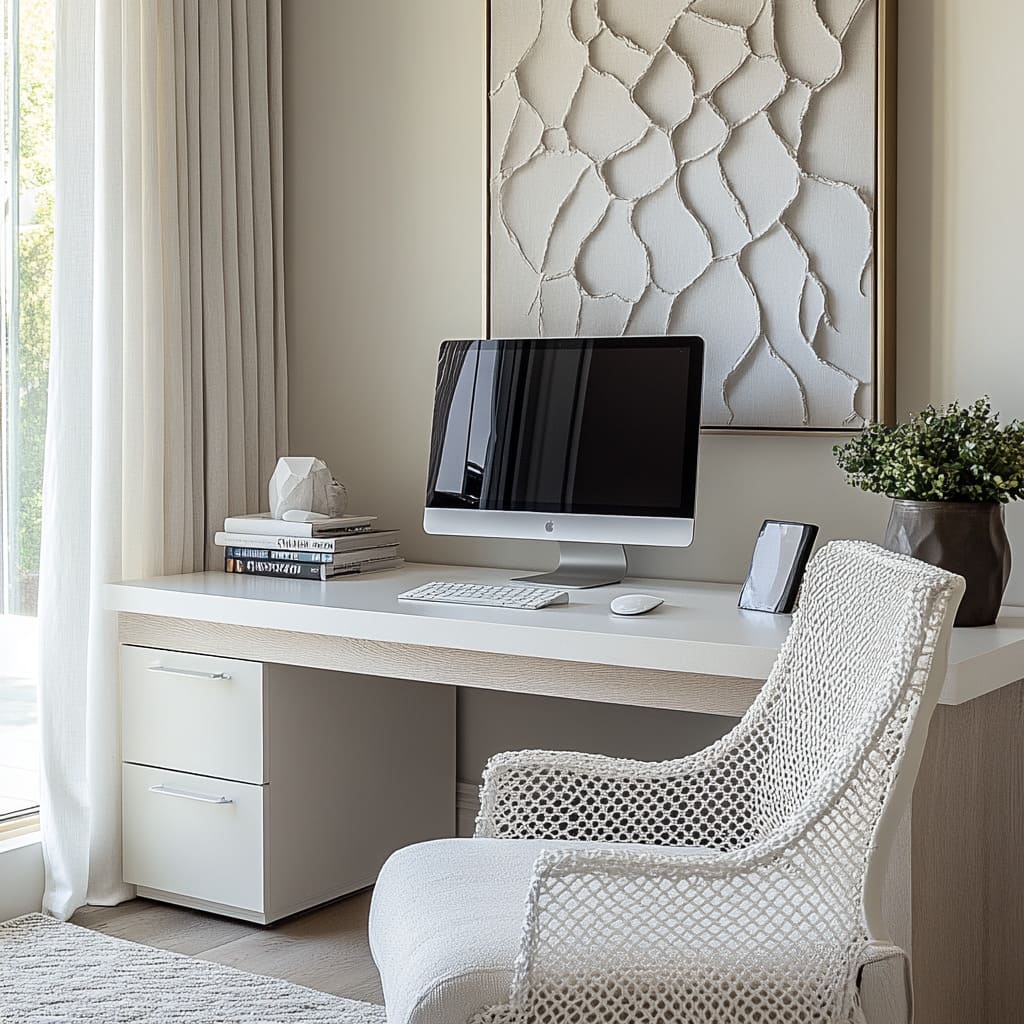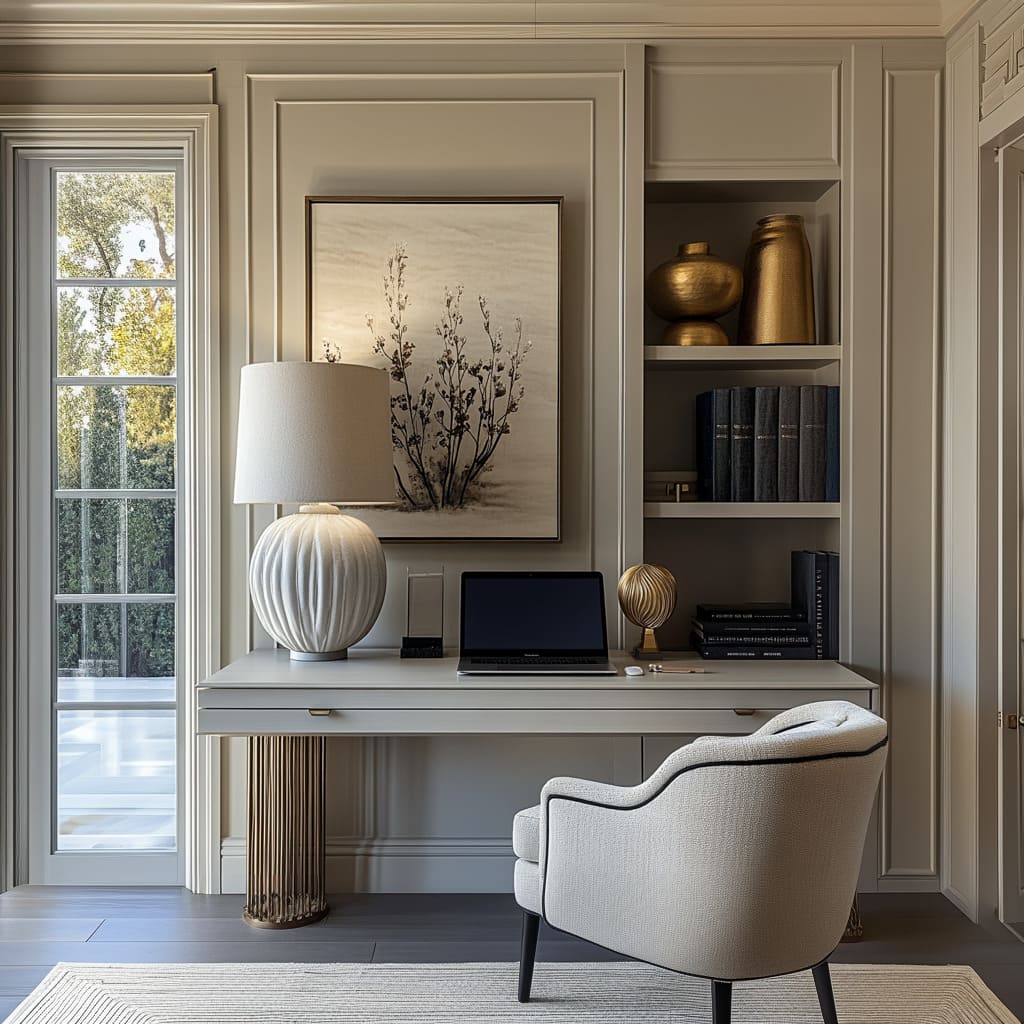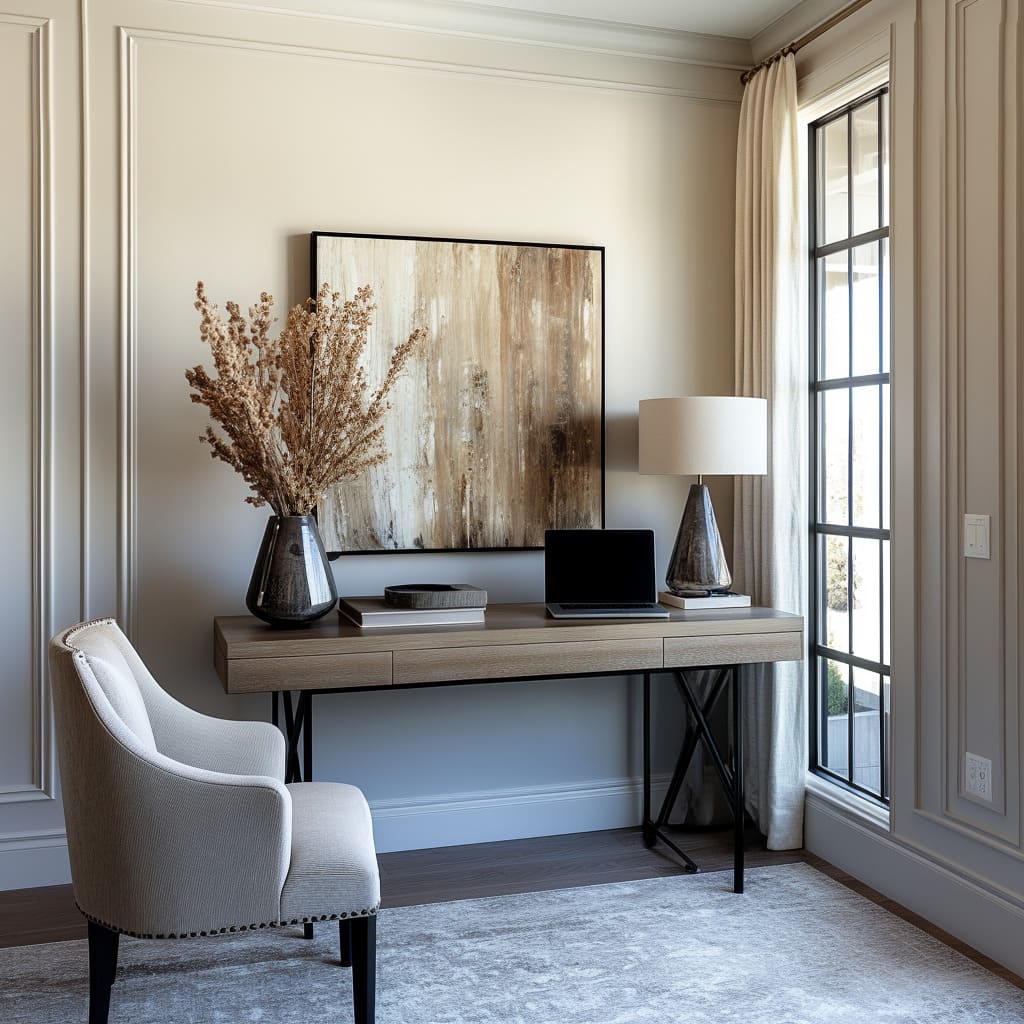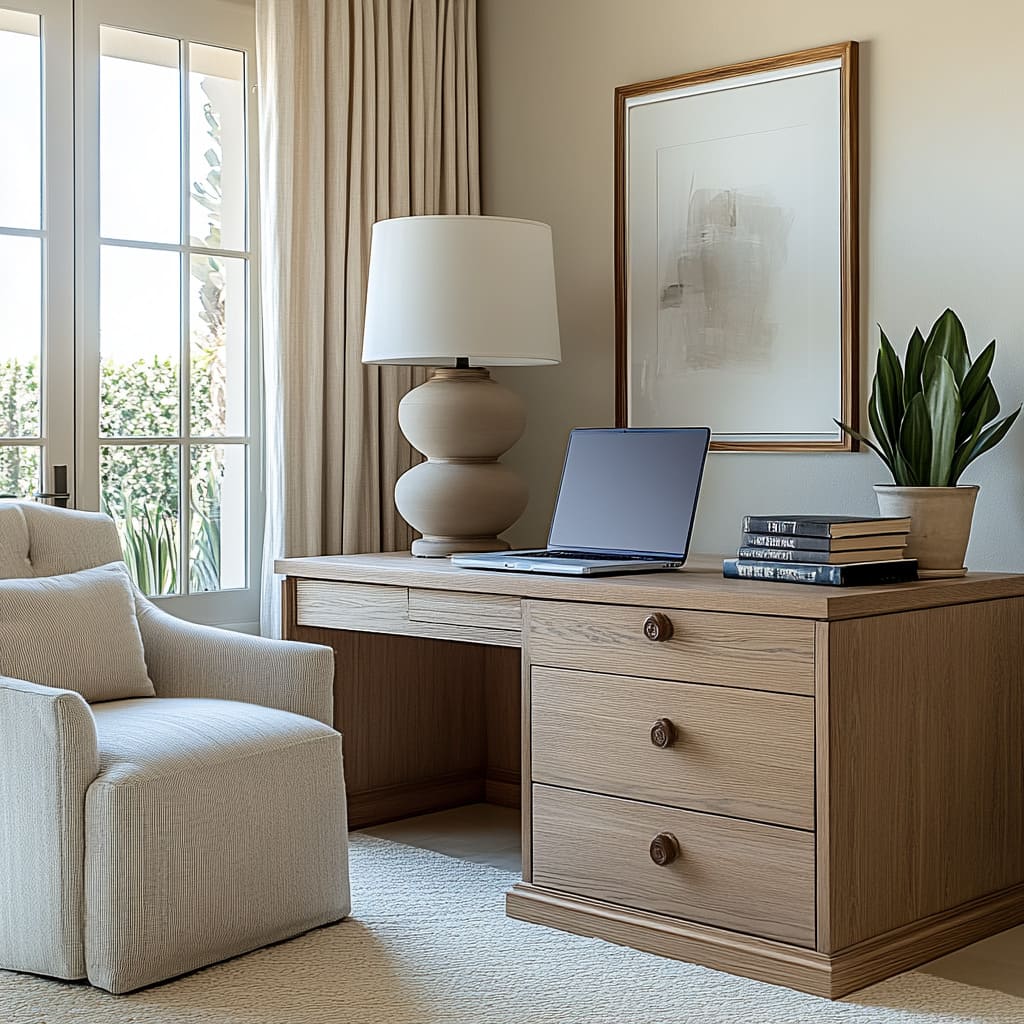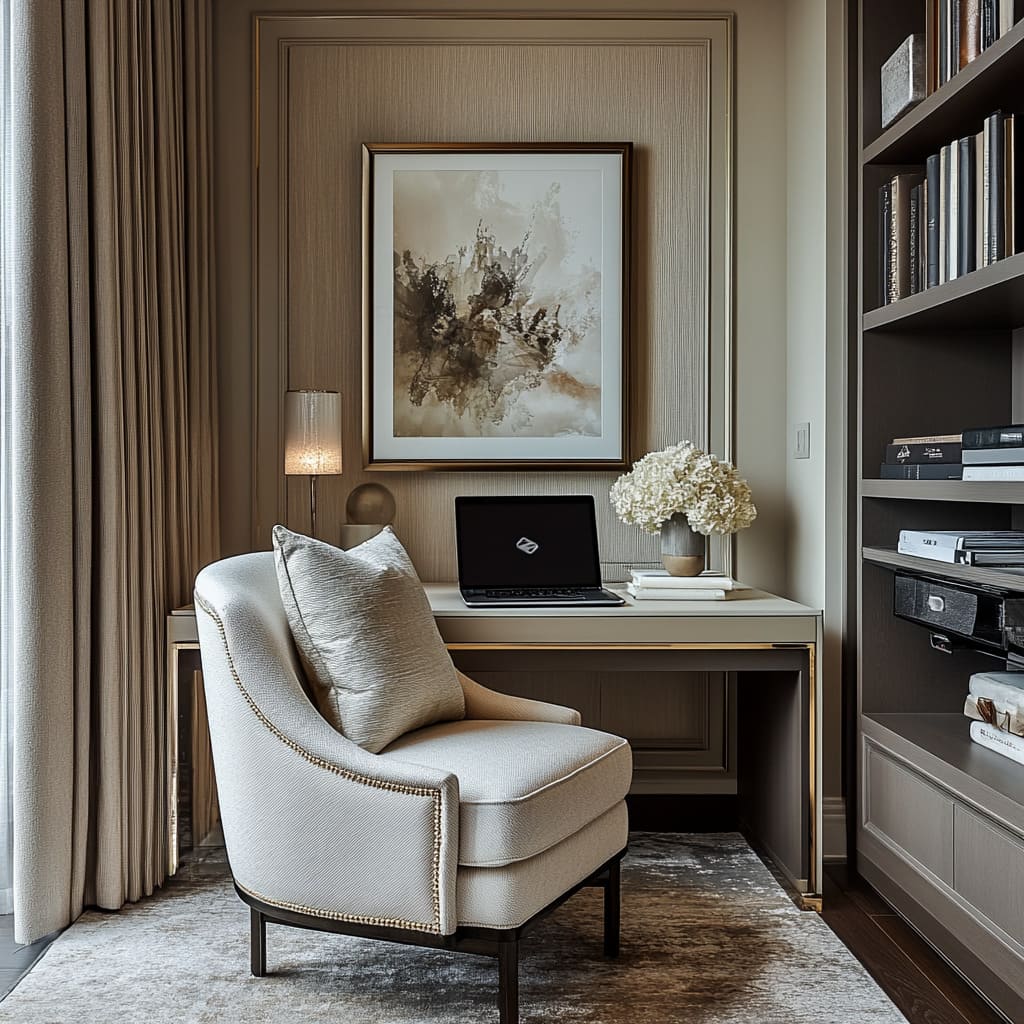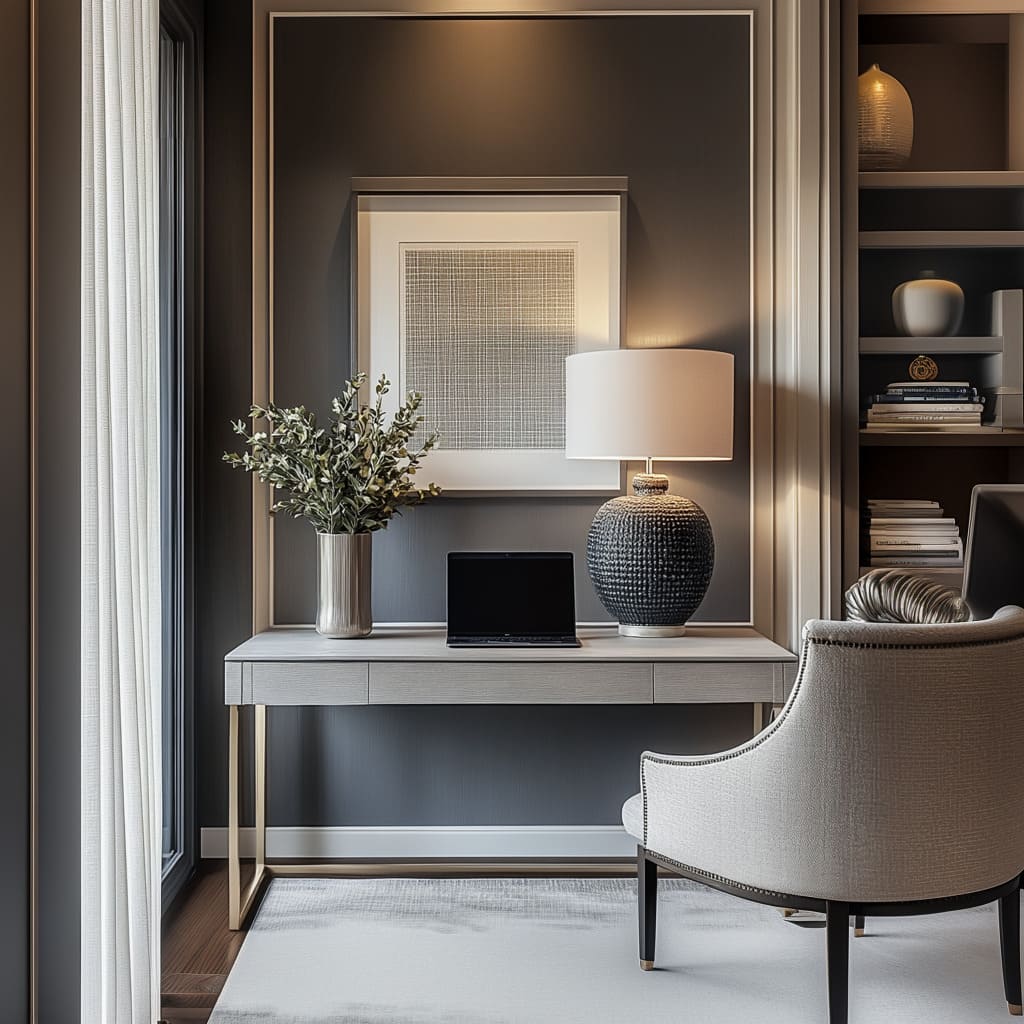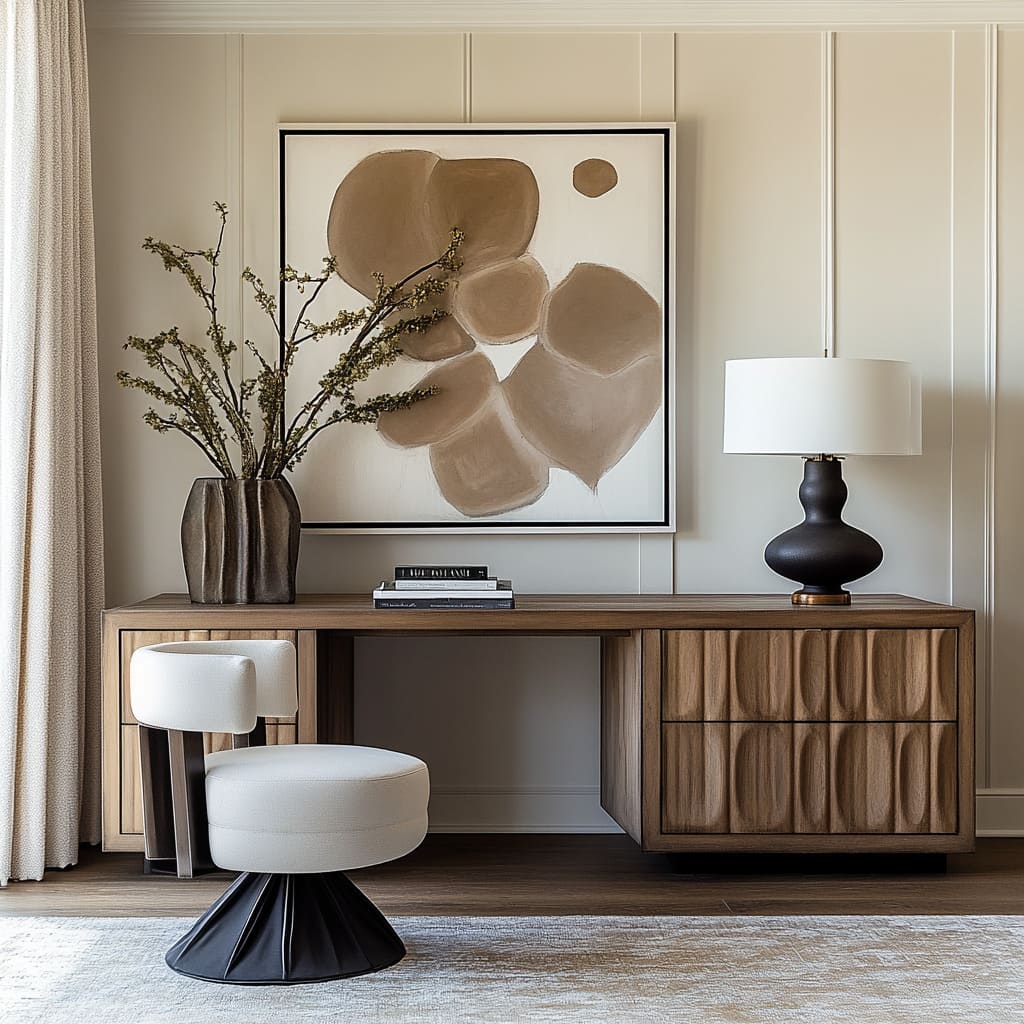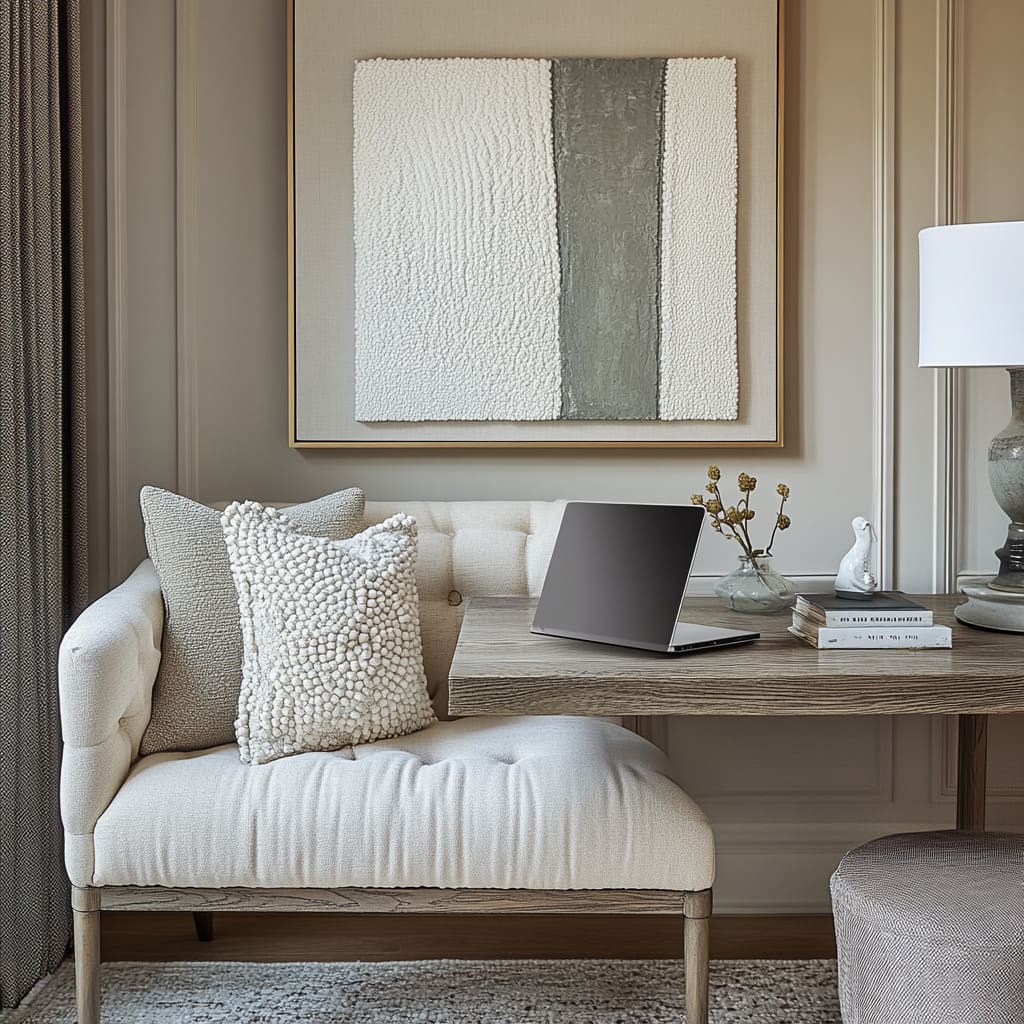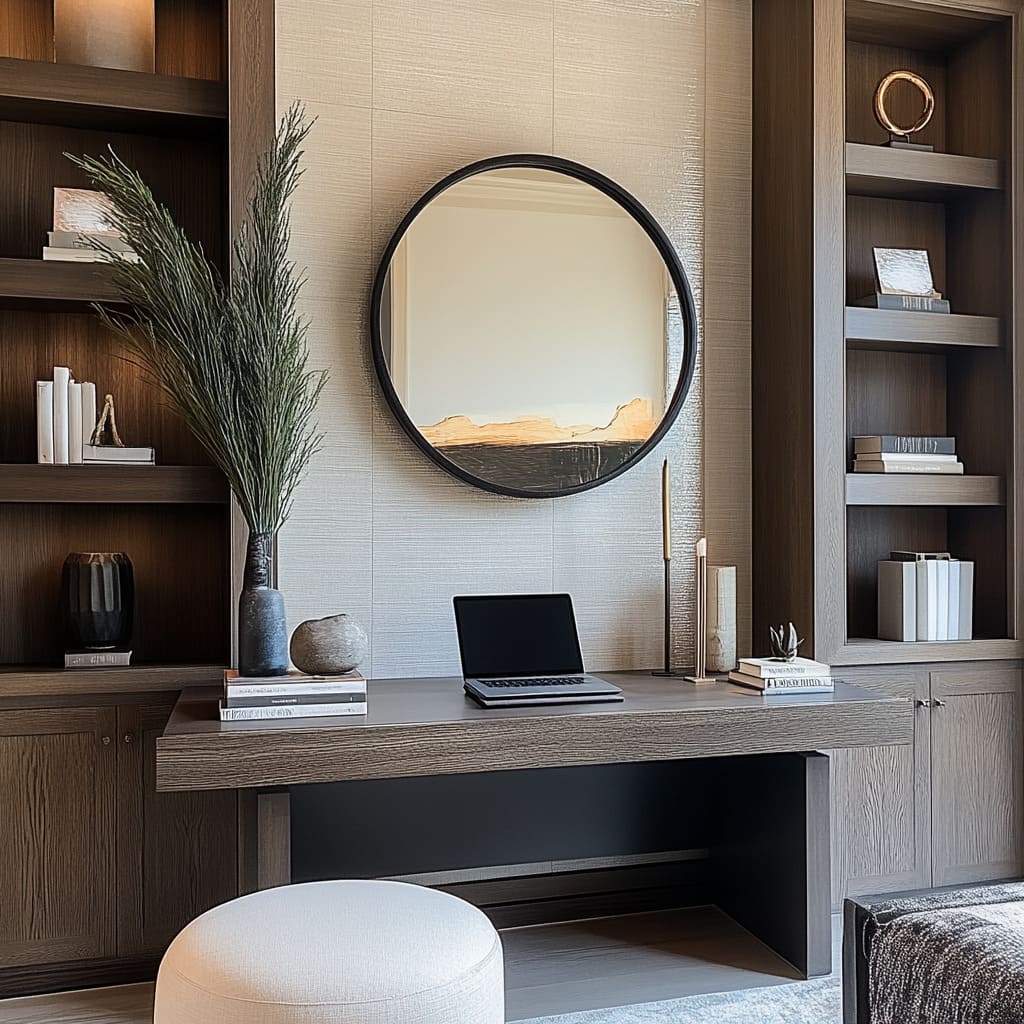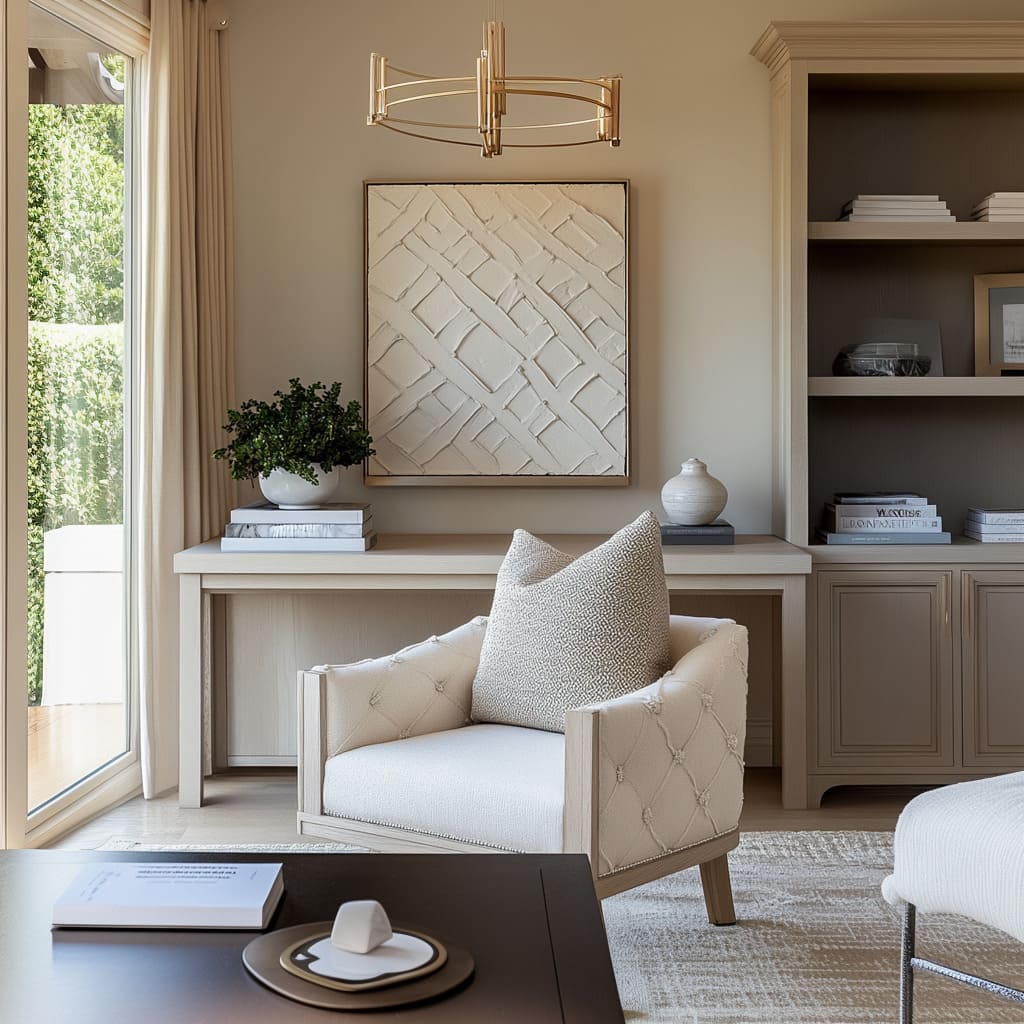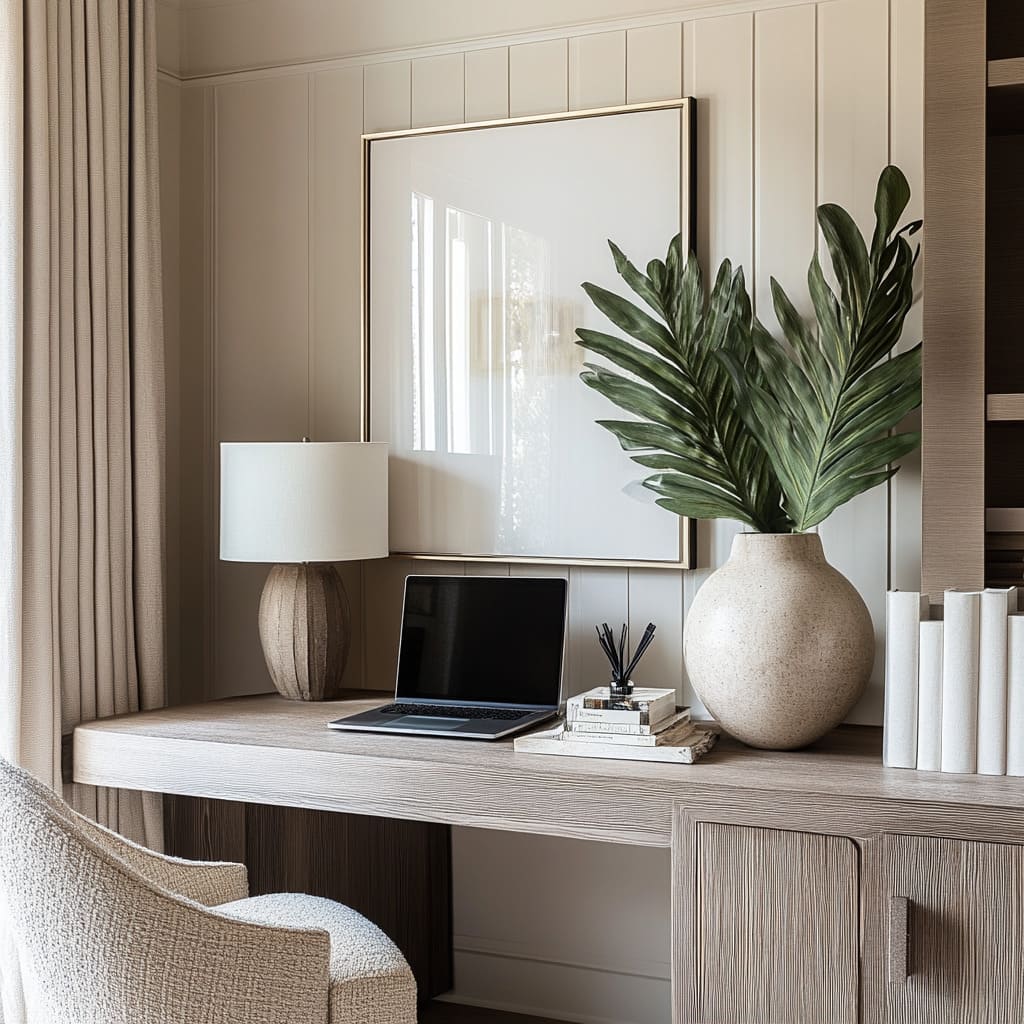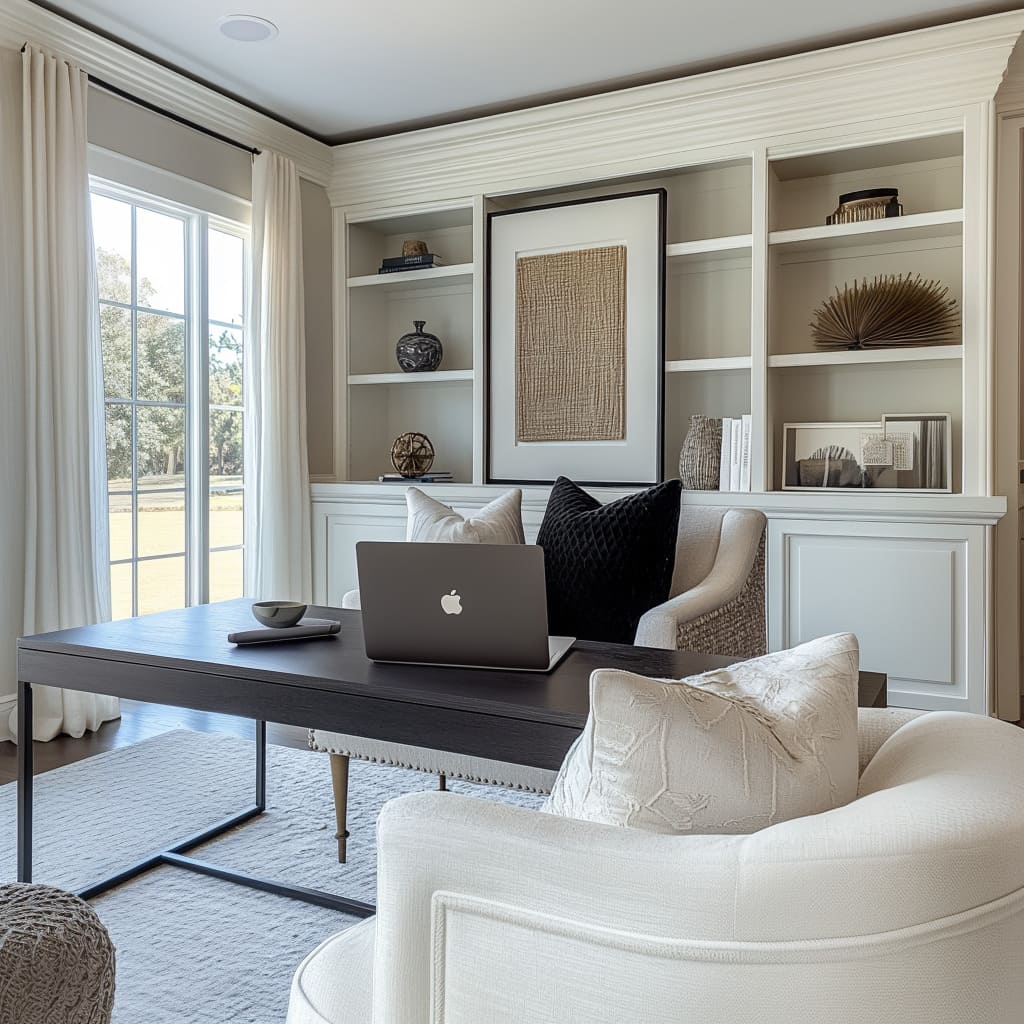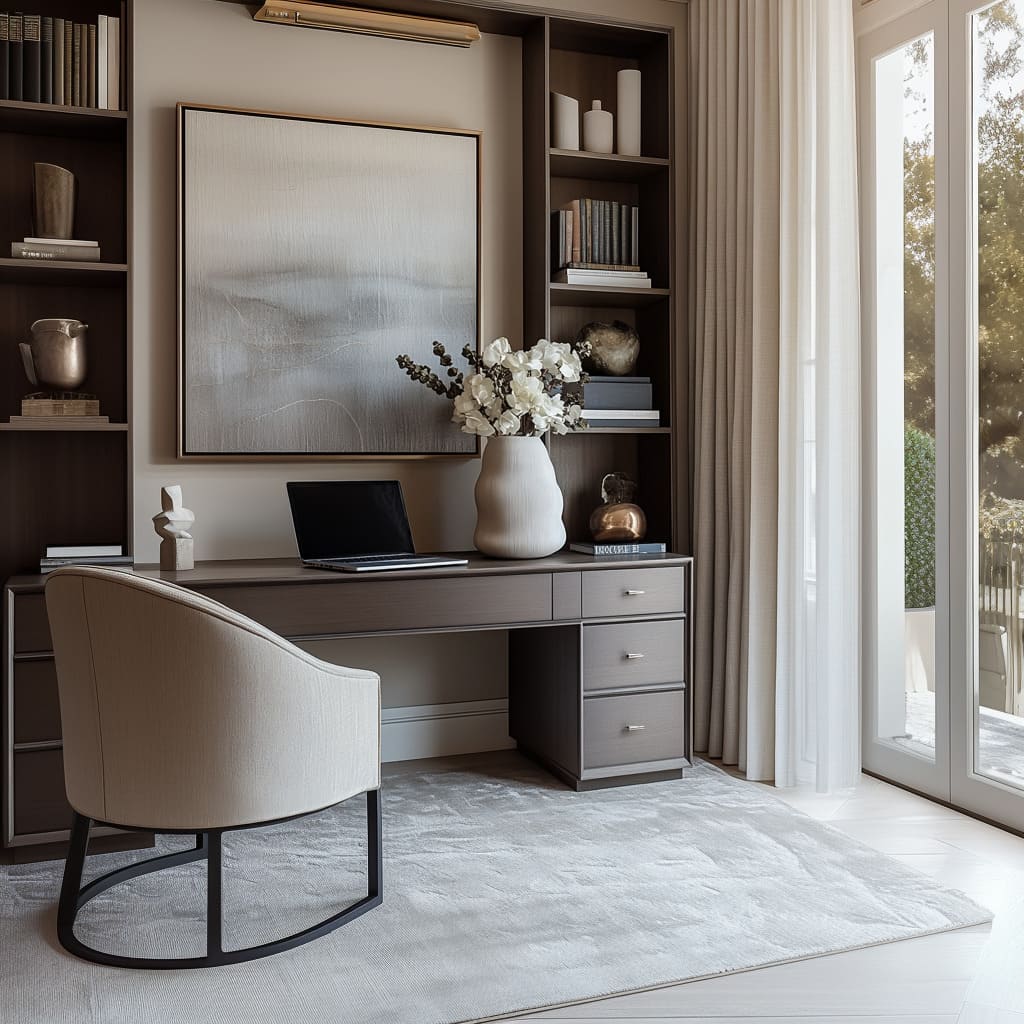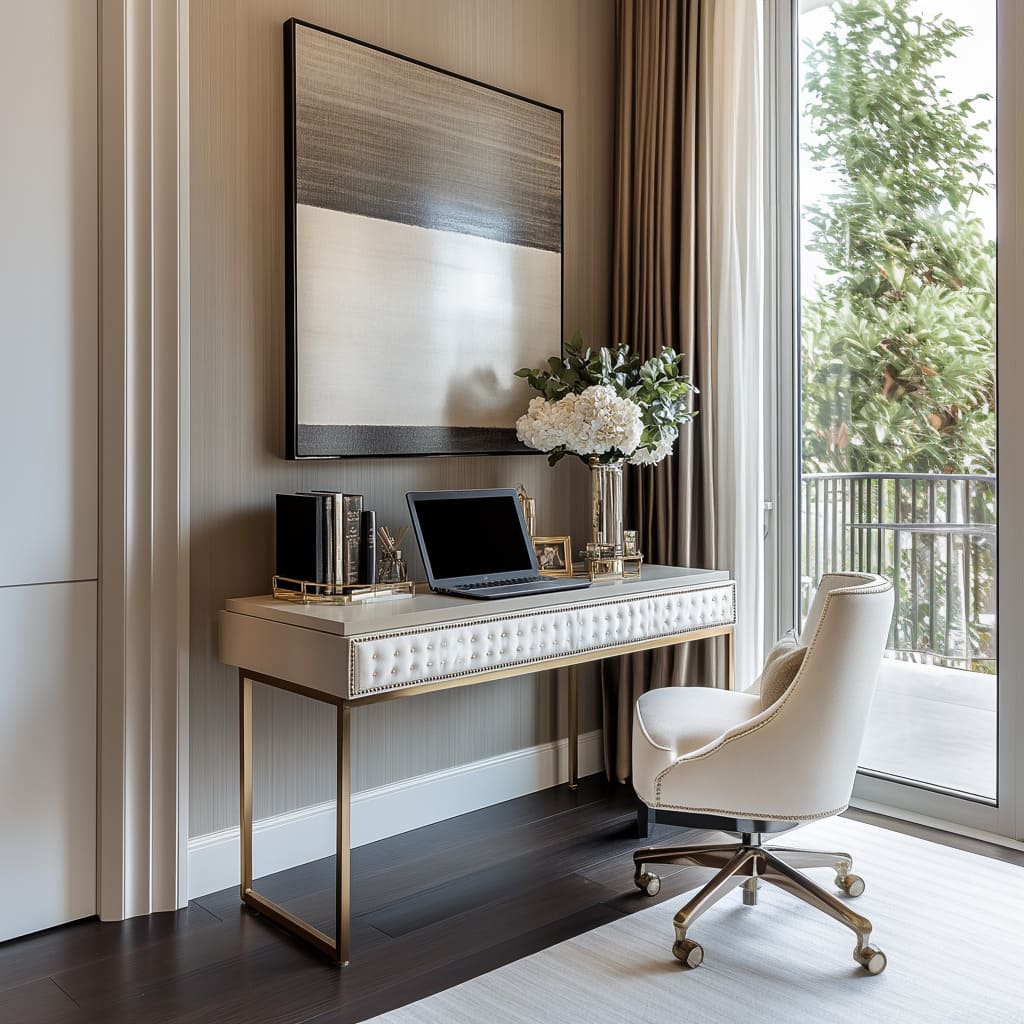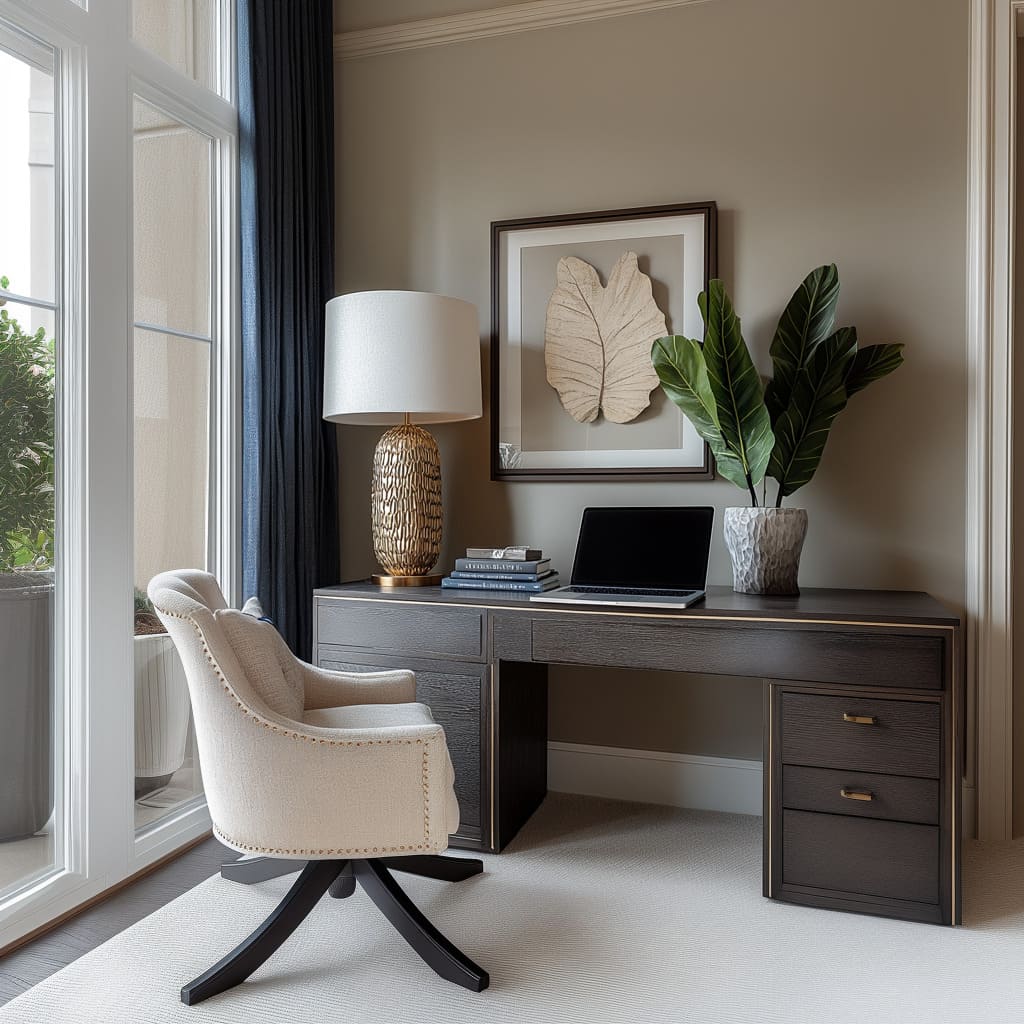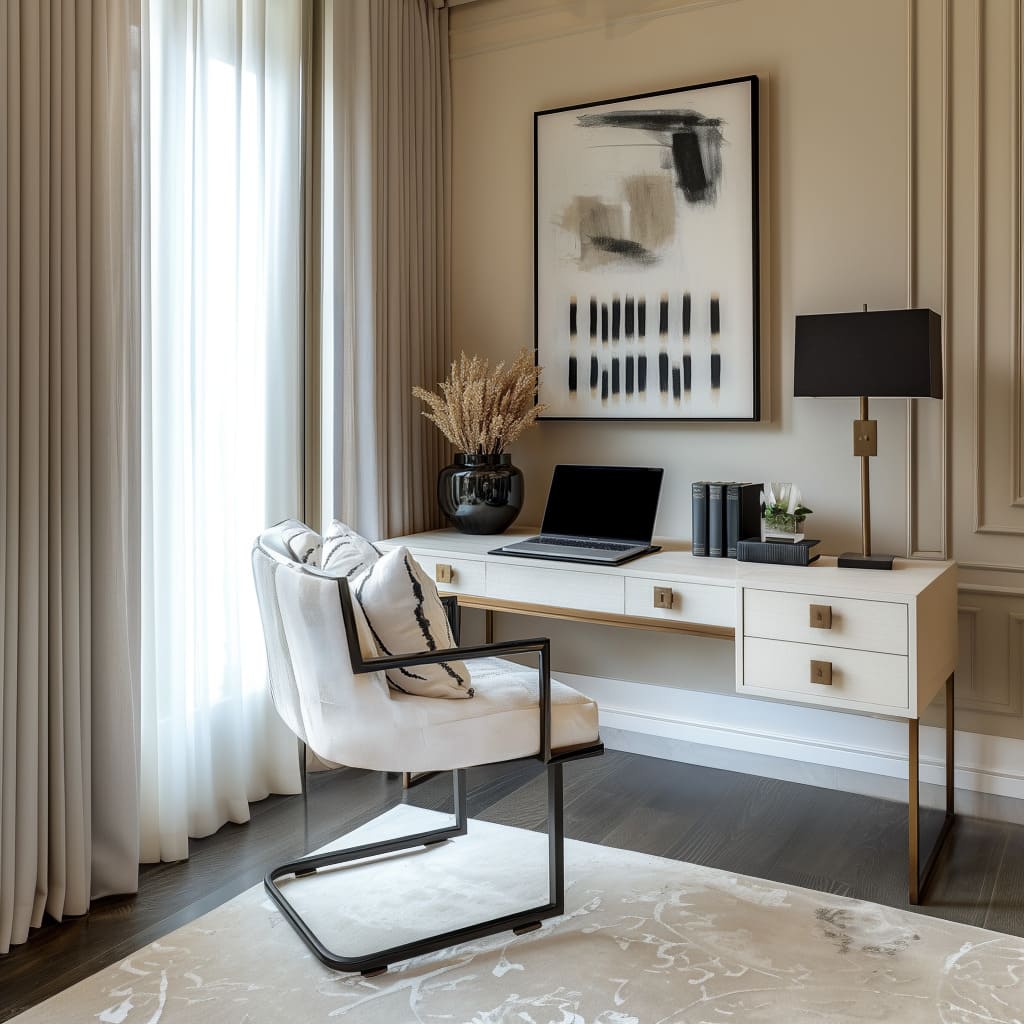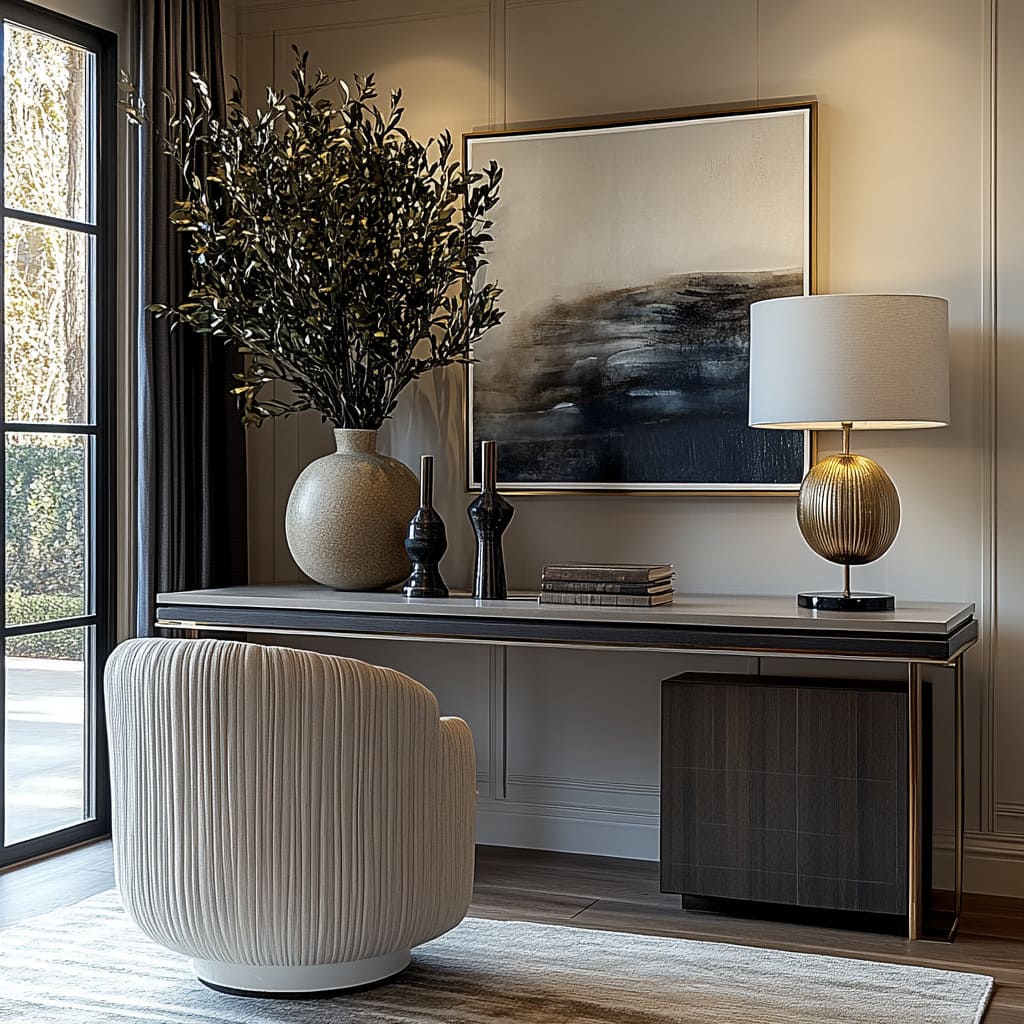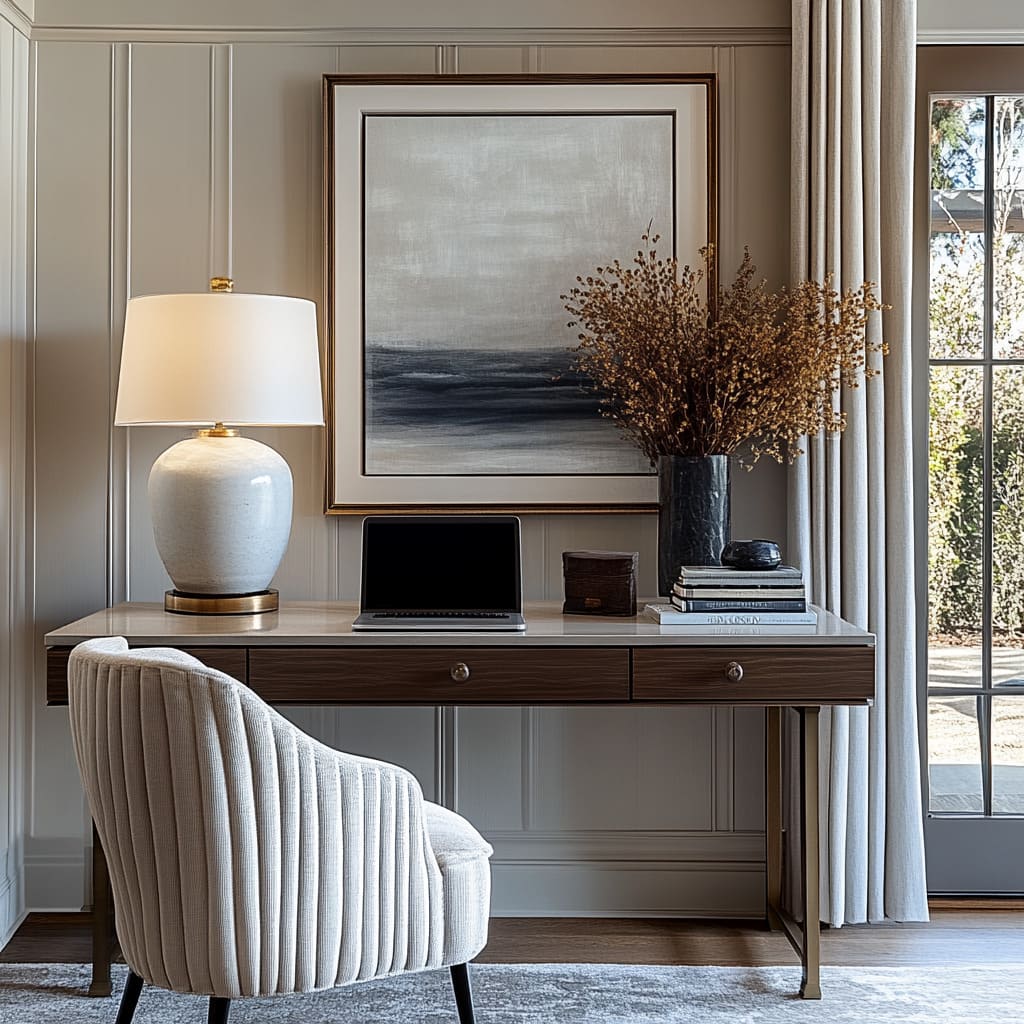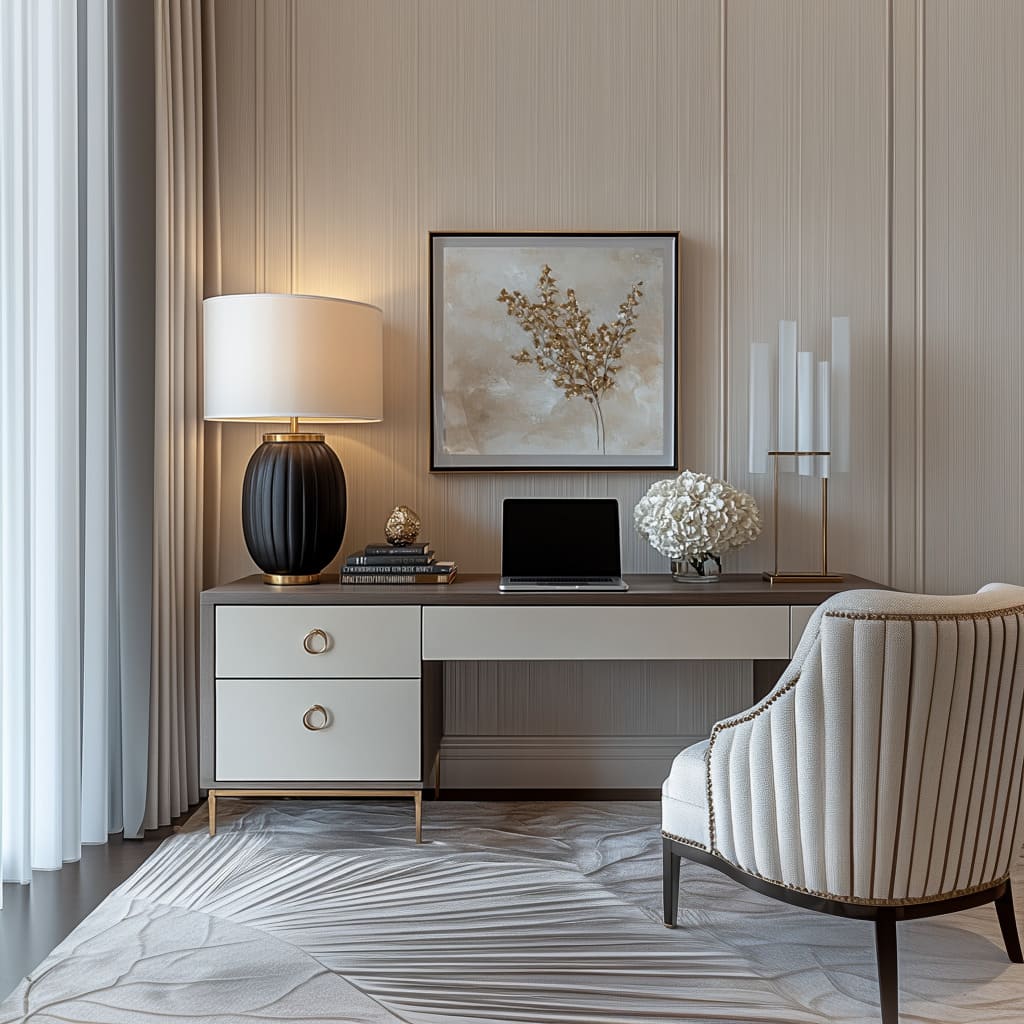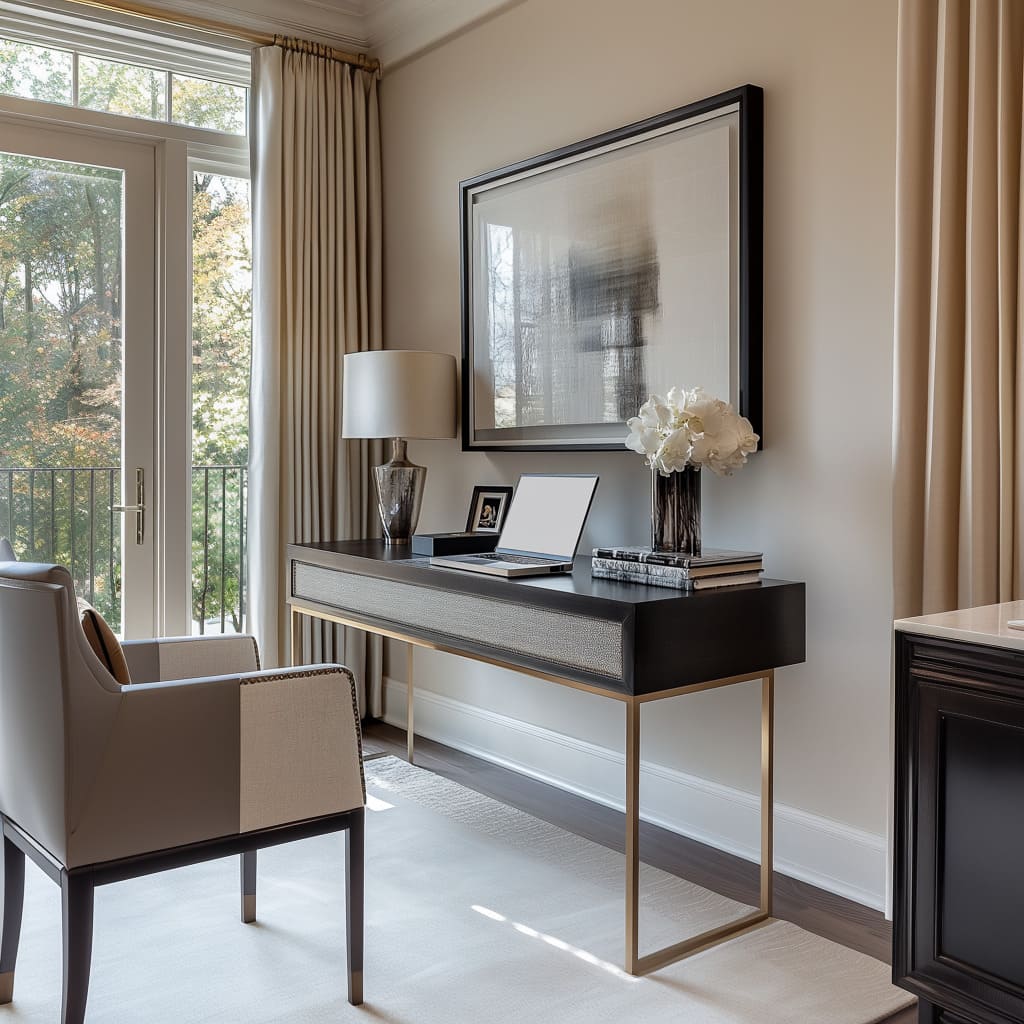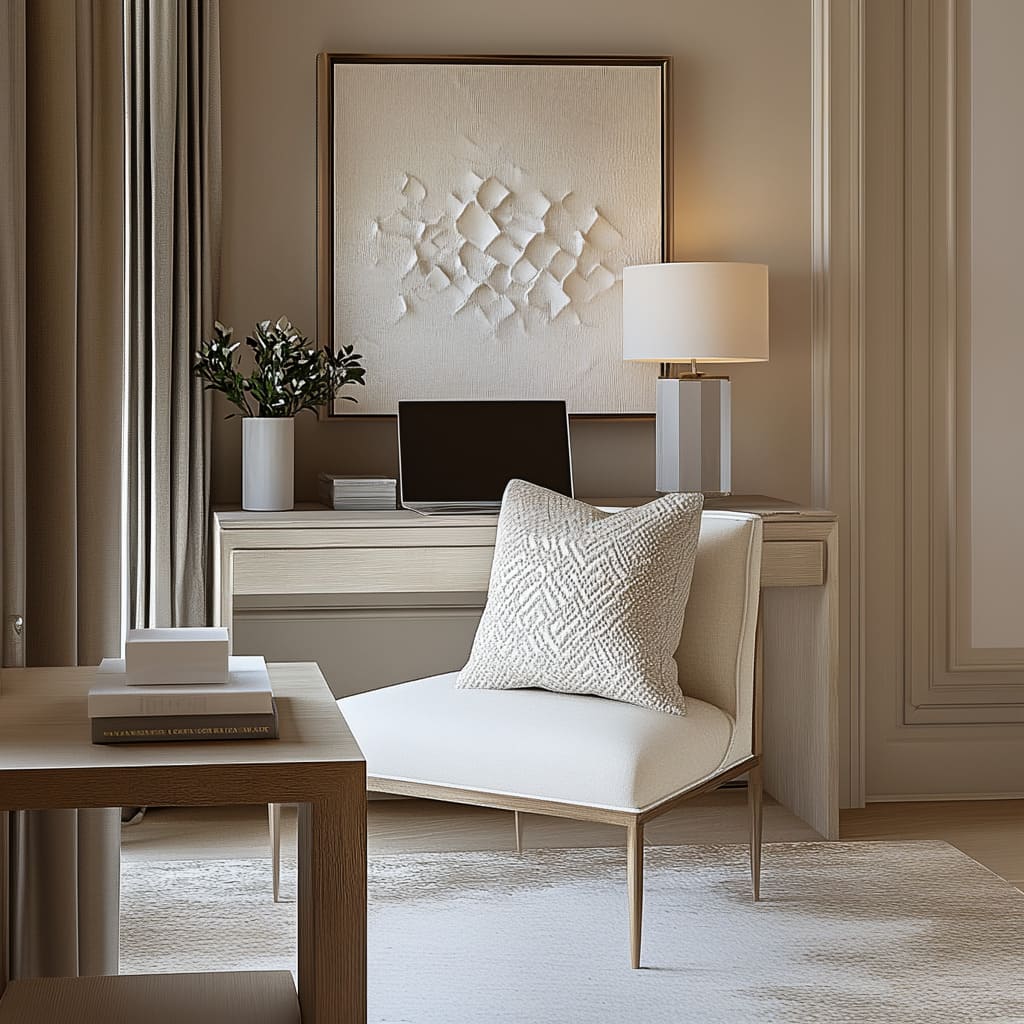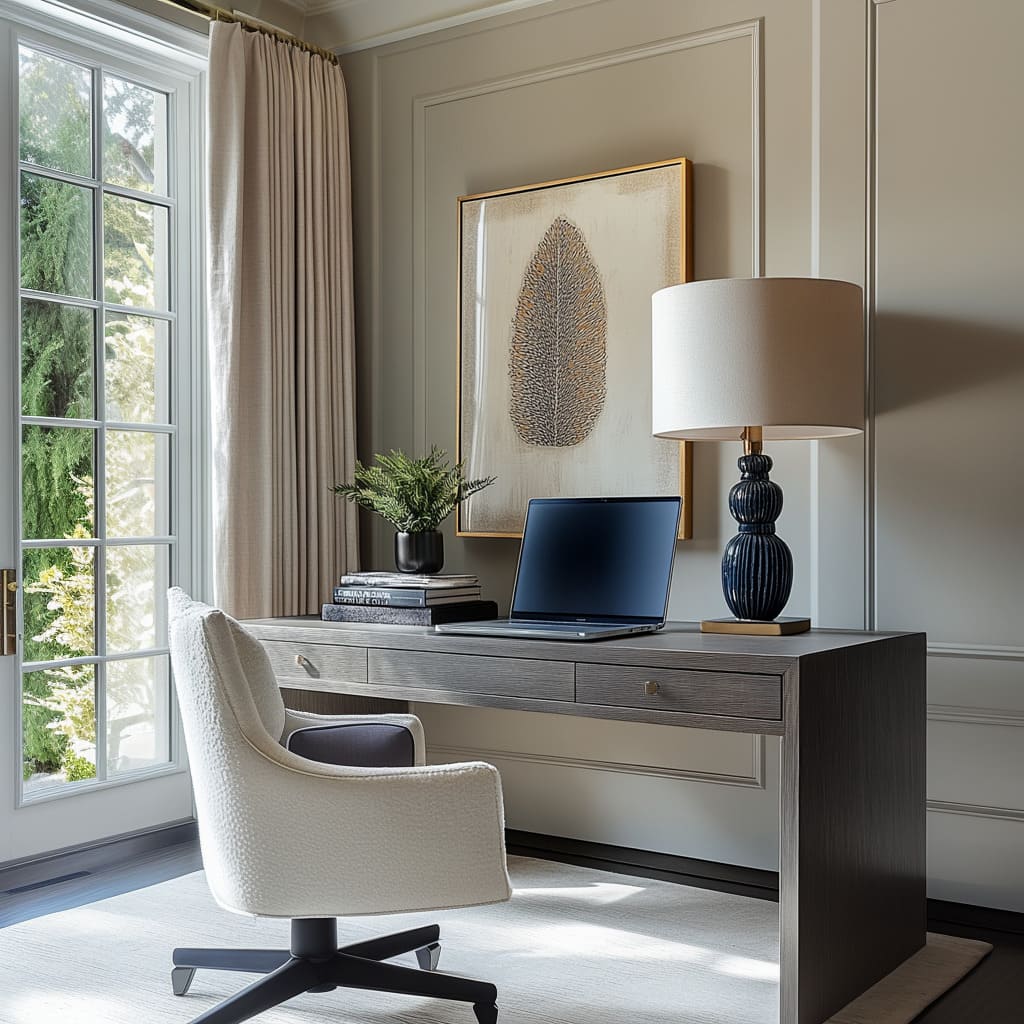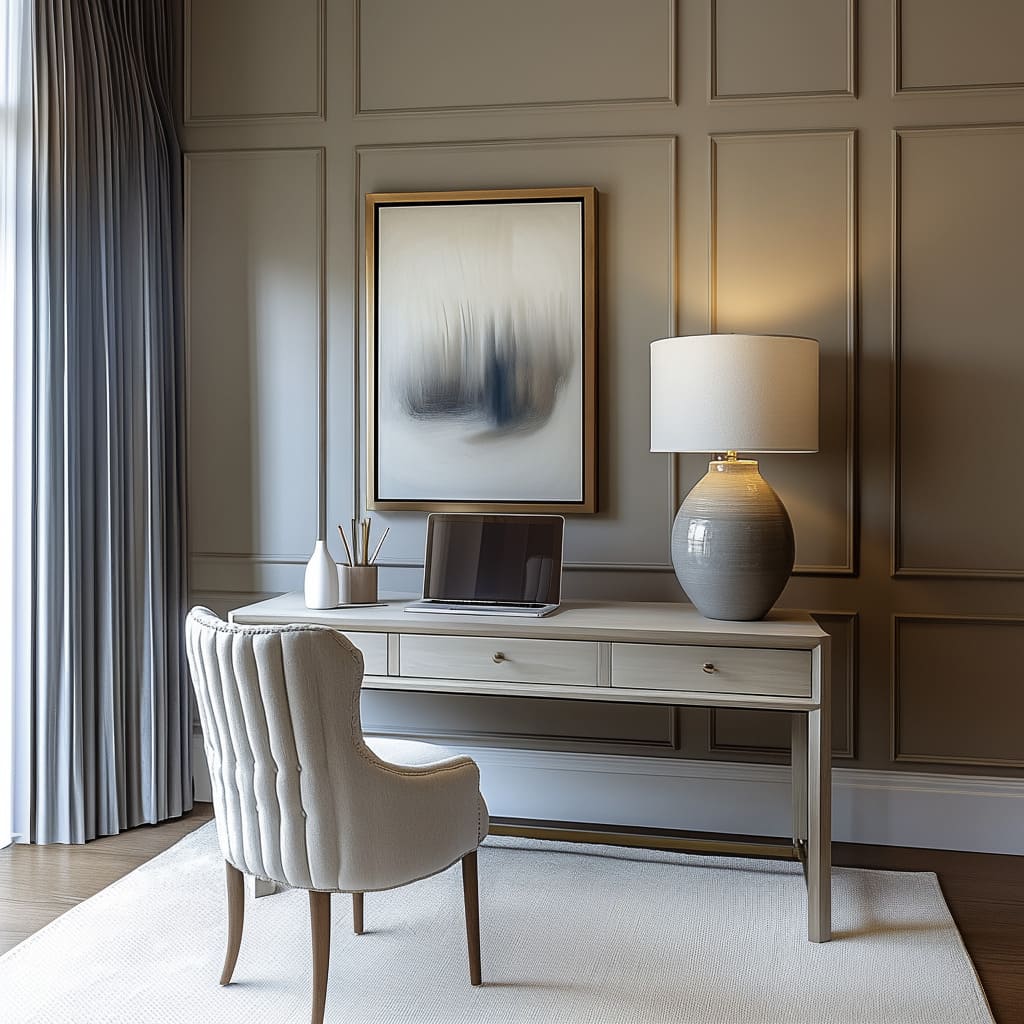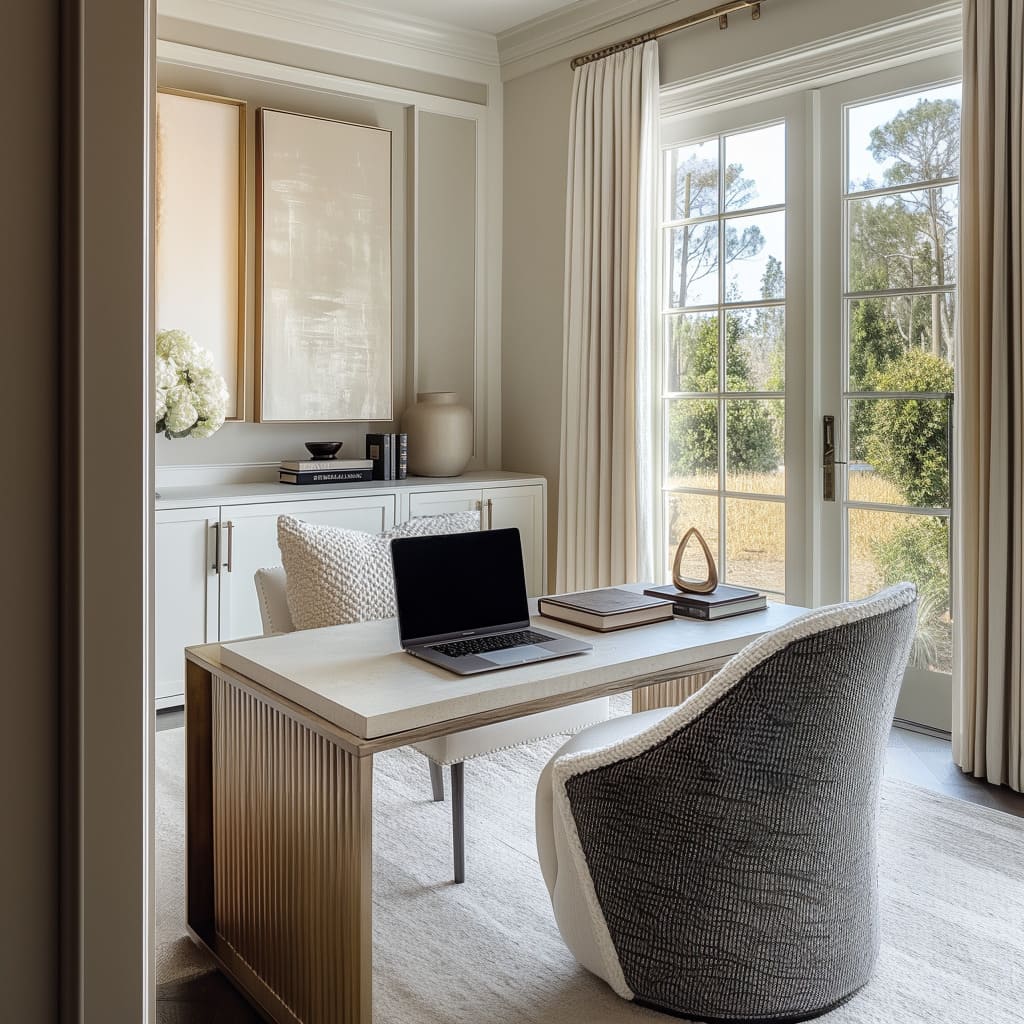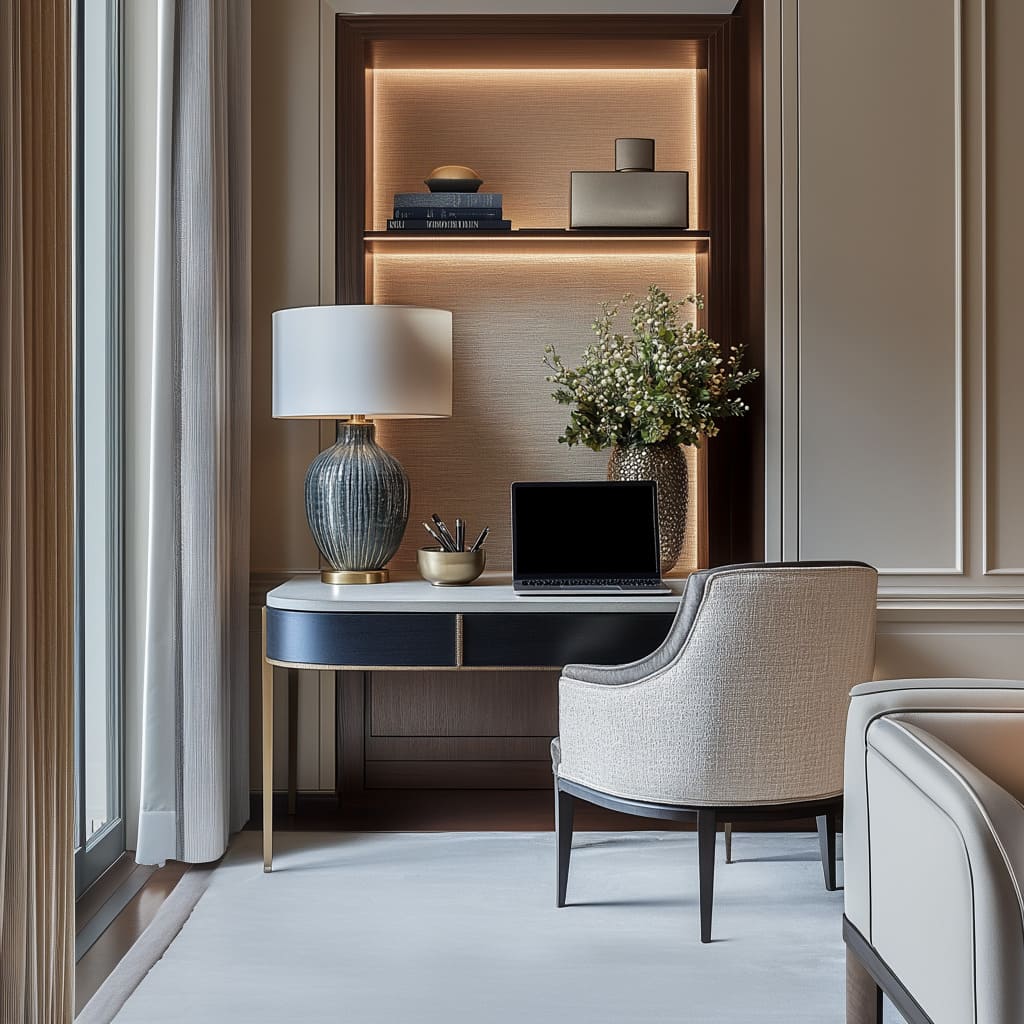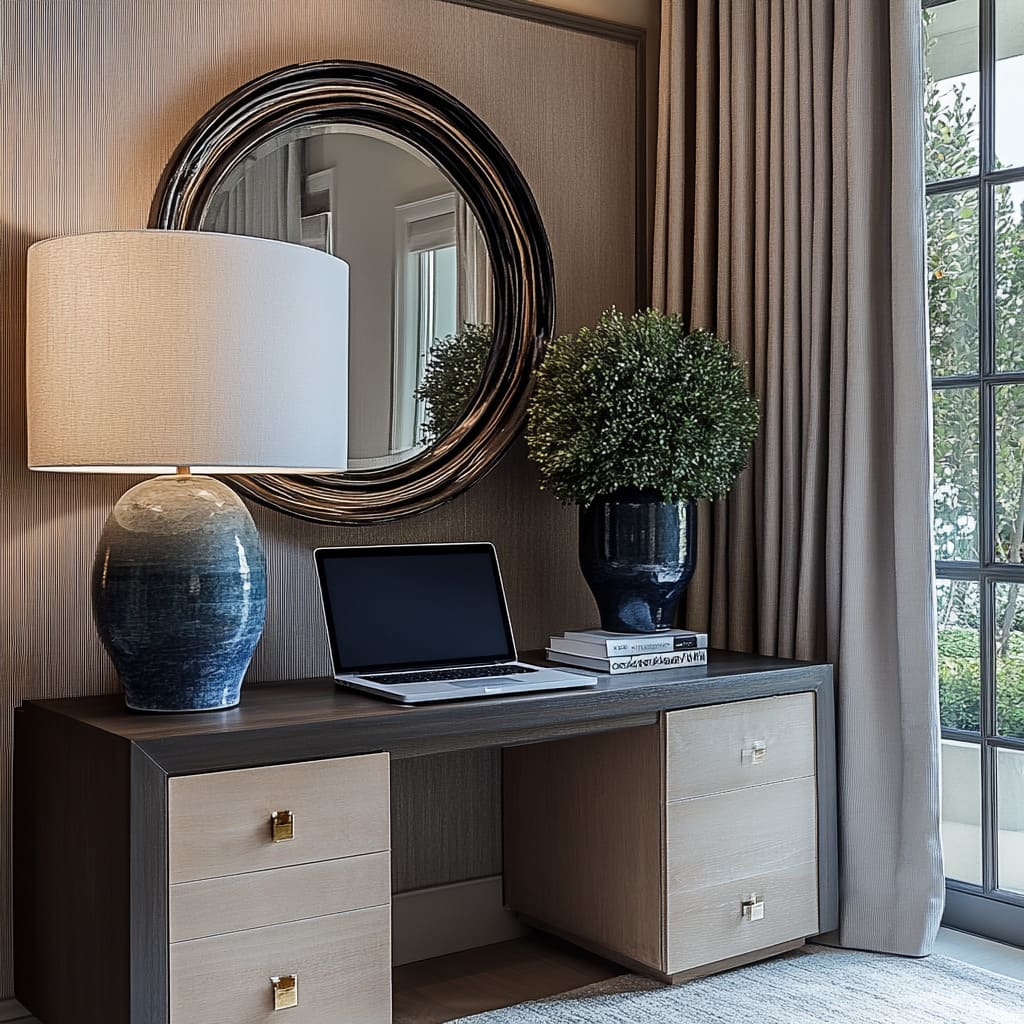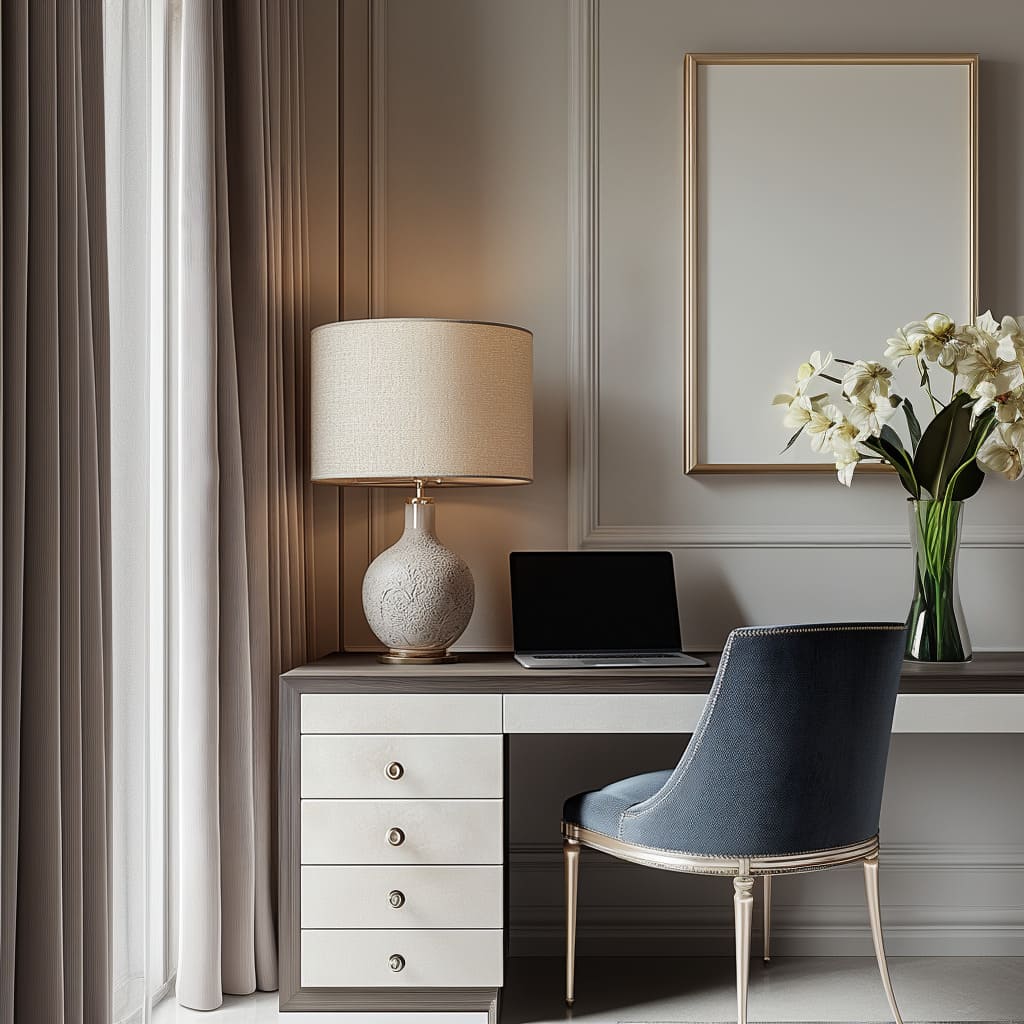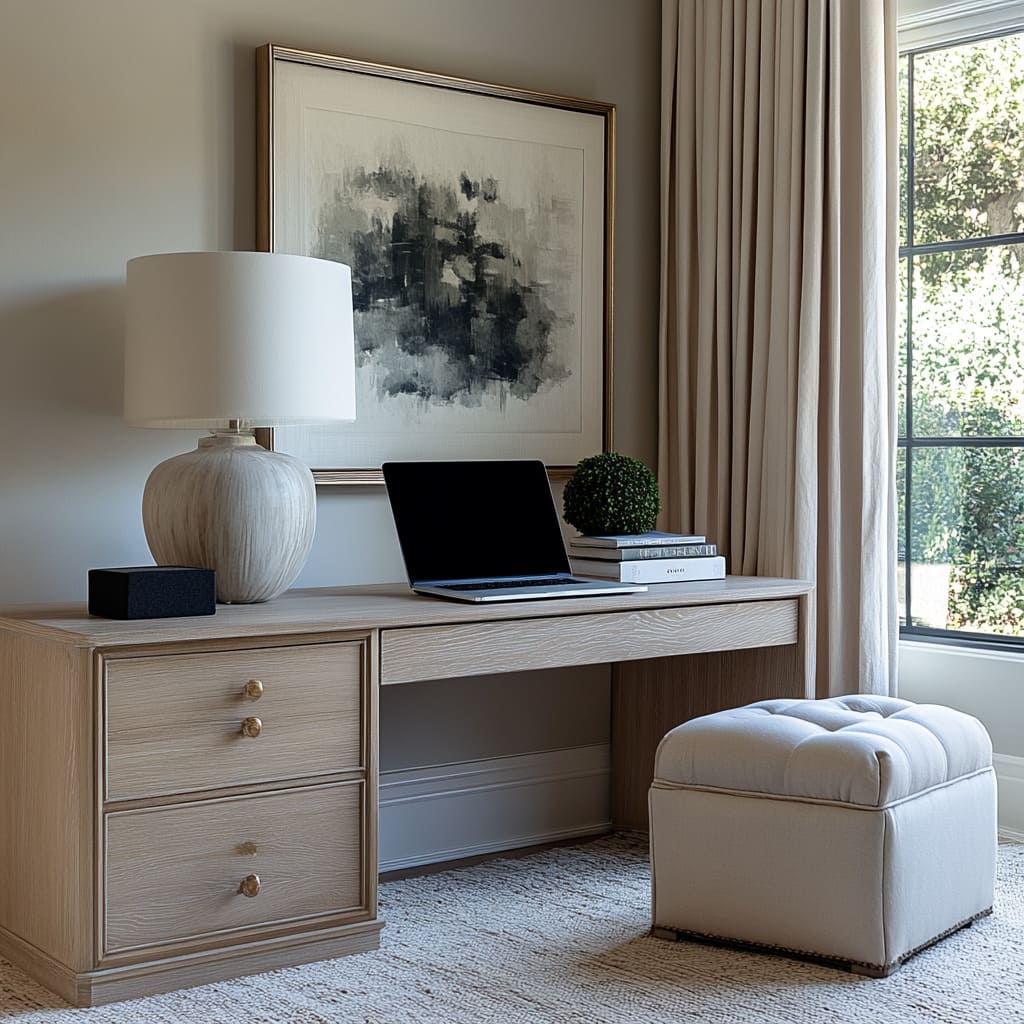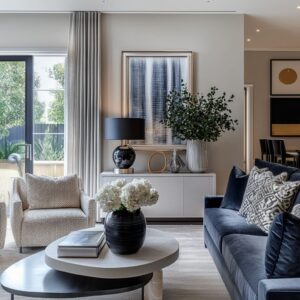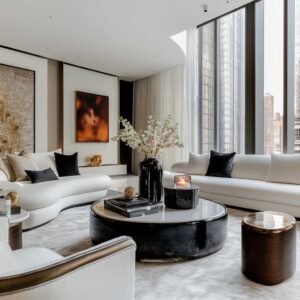Creating an inviting and inspiring home office doesn’t have to be a daunting task. In this article, we’ll take a closer look at elegant home office ideas, focusing on the subtle touches and thoughtful details that bring sophistication and functionality to your workspace.
By analyzing overlooked elements and timeless design principles, this guide will help you understand what defines a refined home office and how these concepts can work in harmony with your personal style.
Whether you’re drawn to modern minimalism or transitional charm, this discussion highlights practical approaches to elevate your home office with tasteful solutions. From integrating soft color palettes to selecting furniture that balances comfort with design, every aspect matters when shaping a workspace that supports both productivity and a sense of calm.
By the end of this piece, you’ll have a fresh perspective on designing a workspace that blends aesthetic appeal with everyday practicality.
Key Design Insights for Sophisticated Home Offices
Harmonizing Materials with Care
The most refined home offices showcase an intentional mix of materials—wood, metal, ceramics, and textiles—within a controlled color palette. The contrast between smooth desk surfaces and soft, upholstered seating creates an understated yet dynamic visual experience.
This balanced interplay of textures adds depth without detracting from the room’s functionality.
Lighting as a Central Feature
From large, sunlit windows to elegant drapery and thoughtfully positioned lamps, lighting is a defining element in these spaces. While natural light enhances focus and energy, strategically chosen lamps bring a welcoming glow and act as functional decor.
The layering of light sources ensures versatility throughout the day.
Art That Grounds the Space
Abstract or textured artwork plays a quiet but impactful role in these designs. Positioned above desks or shelving units, the pieces add character without dominating the room.
These selections often feature subtle tones and geometric shapes, complementing the structured elements of furniture and storage.
Natural Touches for Warmth
Incorporating plants, dried branches, or floral arrangements softens the overall look, offering contrast to the harder edges of furniture. These organic additions not only breathe life into the workspace but also introduce a touch of nature that balances the more polished materials.
Restrained Color Choices
Neutral shades—think whites, creams, taupes, and grays—serve as the foundation of these designs. Accented with metals such as brass or bronze, these tones promote a sense of calm while allowing key features to stand out.
The restrained use of color reflects a careful curation that adds to the space’s sophistication.
Texture as Subtle Ornamentation
Decorative elements often come in the form of texture rather than bold patterns. Ribbed lamp bases, tufted seating, carved wood drawer fronts, or patterned rugs bring richness and dimension to these rooms.
By using texture in place of intricate designs, the spaces remain clean and uncluttered. Whether you’re looking for inspiration to refresh your workspace or aiming to design an elegant home office, these approaches show how thoughtful choices in materials, lighting, and decor can elevate both the look and feel of the room.
Refined Approaches to Home Office Design
Blending Materials with Precision
A hallmark of these designs is the thoughtful combination of materials like wood, metal, ceramics, and textiles. This interplay is subtle yet effective, where sleek wooden surfaces meet the softer textures of upholstered chairs.
For example, pairing an elegant home office desk with tactile fabrics elevates both comfort and aesthetic appeal, creating a workspace that feels intentional and refined.
The Role of Lighting in Atmosphere
Lighting plays a transformative role, with an emphasis on natural light complemented by strategically placed lamps. Floor-to-ceiling drapery not only frames large windows but also contributes a sense of grandeur, while well-designed lamps add warmth and visual interest.
This balance between functional and decorative lighting is key to a productive yet inviting environment.
Artwork That Grounds the Design
Incorporating abstract or textural artwork serves as a focal point that doesn’t dominate the space. The subtle movement in these pieces counterbalances the linearity of desks and shelving, giving the room depth and personality.
This approach ensures the workspace remains visually engaging without becoming overwhelming.
Natural Elements for Balance
Organic elements like potted plants, dried branches, or understated floral arrangements introduce a refreshing vitality to these spaces. They soften the sharper lines of furniture while bridging the gap between functionality and comfort.
Even a small touch of greenery can transform the mood of a home office.
Embracing a Restrained Palette
Neutral tones dominate, with shades of white, taupe, and gray providing a serene backdrop. These hues are often accented by metals like brass or bronze, lending a polished yet understated finish.
This careful curation ensures that every element in the room feels purposeful.
Using Texture as a Design Element
Texture emerges as a subtle yet powerful tool in these offices. Whether it’s a patterned rug, ribbed lamp base, or the grain of a wooden desk, these details create layers of interest without relying on busy patterns.
Texture becomes a form of ornamentation, enriching the space in quiet yet impactful ways.
Balancing Forms and Silhouettes
Combining straight and curved lines is another key strategy, evident in the mix of rectangular desks and round lamps or vases. This interplay adds harmony, preventing the room from feeling overly rigid or overly soft.
Introducing one curved piece into a space dominated by angles can dramatically change the dynamic.
Elevating Storage and Organization
Hidden storage solutions in desks and shelving keep the visual field clean and uncluttered. While open shelving showcases decorative pieces, concealed compartments ensure that practical items remain out of sight, promoting a sense of order and calm in the workspace.
Enhancing Light and Space
Mirrors and reflective surfaces amplify natural light and create an illusion of spaciousness. Placing a mirror across from a window or choosing glossy finishes for desk accessories helps brighten the room while maintaining its sophisticated tone.
These thoughtful approaches highlight how balancing materials, light, texture, and form can create a workspace that’s both functional and inspiring. Whether you’re redesigning your office or adding new elements, the right choices can bring elegance and practicality to the forefront.
Practical Tips for Bringing These Designs into Your Own Space
Establish a Neutral Foundation
Start with walls in a soft, neutral tone like cream, taupe, or light gray. This understated backdrop allows other elements in your elegant home office design—such as the desk or art pieces—to take center stage, creating a balanced and refined environment.
Highlight One Statement Piece
Whether it’s a striking desk, a sculptural chair, or a bold piece of artwork, let one standout element anchor the room. By designing the space around this central feature, you can maintain a cohesive and intentional aesthetic.
Balance Comfort with Practicality
A comfortable chair, proper lighting, and adequate storage are essential to a workspace you’ll actually enjoy using. While style is crucial, functionality plays an equally important role in creating a home office that supports productivity.
Introduce Subtle Layers of Texture
Combine soft fabrics like linen or boucle with wood finishes in light oak or walnut. Accent these with hints of metal—think brass lamp bases or silver drawer handles—for subtle depth.
These layers make the space visually engaging without overwhelming it.
Stick to a Simple Palette
Limit your color scheme to two or three main tones, such as white, gray, or beige, complemented by an accent color or metallic finish. This approach ensures the room feels polished and avoids unnecessary clutter.
Incorporate Natural Elements
Add a touch of nature with greenery or organic materials. A tall potted plant, dried florals, or a woven basket introduces warmth and offsets the structured feel of desks and shelving.
Consider the Vertical Dimension
Think beyond the horizontal plane by incorporating tall elements like floor-length curtains, vertical artwork, or standing lamps. These additions draw the eye upward, giving the room an expansive and airy feel.
Curate with Intent
When decorating, less is more. Opt for a few high-quality, coordinating pieces over an assortment of mismatched items.
A cohesive selection of objects—like vases, books, or sculptures—ensures the space looks thoughtfully designed.
Play with Reflective Surfaces
Strategically include glossy or mirrored finishes to enhance brightness. A mirror above the desk or a lamp with a reflective base can add just the right amount of shine without overpowering the space.
Add Personal Details
Finally, give the room your own touch with framed photographs, meaningful books, or small personal artifacts. By incorporating these within the overarching design scheme, you’ll create a workspace that feels both stylish and uniquely yours.
By focusing on these foundational elements, you can craft a home office that balances sophistication with everyday usability, making it a space you’ll love to work in.
What Makes These Spaces Feel So Refined
Cohesive Metal Accents
One hallmark of these designs is the careful repetition of a single metal finish throughout the room. Whether it’s brushed nickel, aged brass, or matte black, this consistency is seen in lamp bases, drawer pulls, and decorative objects.
By sticking to one finish, the designs avoid visual clutter and achieve a polished, harmonious effect. This subtle approach is one of the core principles behind successful elegant office ideas.
Attention to Scale and Balance
A defining trait of these spaces is how well each piece fits into the room’s proportions. In expansive home offices, large desks and oversized artwork command attention without overpowering the space.
Conversely, smaller setups utilize slimline desks and pared-down accessories to ensure nothing feels cramped. The thoughtful interplay of scale and proportion creates environments that are functional yet visually inviting.
Mastery of Lighting
Natural light takes center stage in most of these spaces, thanks to large windows or glass doors paired with flowing curtains. For evenings, sculptural table lamps or wall sconces add a warm glow and often double as decorative highlights.
This dual approach to lighting keeps the workspace practical and versatile, adapting to any time of day while enhancing the overall design.
The Utility-Aesthetic Balance
Every element serves a purpose—be it practical, decorative, or both. Shelves are curated to hold a mix of books and sculptural vases, while desks feature only the essentials to avoid clutter.
This balance ensures the workspace feels neither over-decorated nor sparse, striking the perfect middle ground.
Unified Color and Material Themes
A clear theme is present in each design, whether it’s a blend of soft neutrals accented with gold or a combination of dark wood and crisp white. This unified approach ensures every piece contributes to the overall aesthetic without competing for attention.
By maintaining this focus, the designs exude cohesion and refinement, making them both inspiring and approachable for personal adaptation. These qualities collectively elevate the designs, ensuring they not only look great but also function seamlessly as workspaces.
Each room demonstrates how thoughtful decisions around materials, lighting, and scale can transform an office into a truly inspiring environment.
Final Thoughts
The featured designs showcase how practicality and visual appeal can seamlessly coexist in a workspace. Through thoughtful choices in textures, layering, and lighting, these home offices demonstrate that functionality doesn’t have to sacrifice style.
By incorporating cohesive color schemes and carefully curated decor, you can recreate this level of refinement in your own space.
Think of these elegant home office design ideas as a guide to merging utility with artistic touches. Whether it’s selecting a standout piece like a sculptural chair, incorporating oversized textural artwork, or placing greenery to bring warmth and life to the room, each detail contributes to a workspace that feels both productive and inspiring.
Even a small adjustment—such as a carefully chosen lamp or an understated rug—can elevate the overall atmosphere.
These ideas are an invitation to rethink your workspace as more than just functional. With just a few intentional design elements, you can create an office that feels inviting, personalized, and visually balanced, setting the tone for both creativity and focus.
